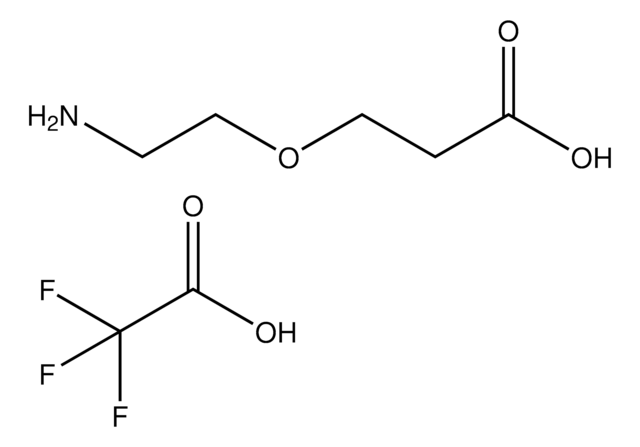07260
6-Aminohexanoic acid
≥98.5% (NT)
Synonym(s):
6-Aminocaproic acid, 6-ACA, Aca, Acp, Aha, Ahx, acikaprin, afibrin, amicar, ε-Aminocaproic acid, 6-Aminohexanoic acid, EACA
Sign Into View Organizational & Contract Pricing
All Photos(1)
About This Item
Linear Formula:
H2N(CH2)5CO2H
CAS Number:
Molecular Weight:
131.17
Beilstein:
906872
EC Number:
MDL number:
UNSPSC Code:
12352202
PubChem Substance ID:
NACRES:
NA.77
Recommended Products
Quality Level
Assay
≥98.5% (NT)
mp
207-209 °C (dec.) (lit.)
SMILES string
NCCCCCC(O)=O
InChI
1S/C6H13NO2/c7-5-3-1-2-4-6(8)9/h1-5,7H2,(H,8,9)
InChI key
SLXKOJJOQWFEFD-UHFFFAOYSA-N
Gene Information
human ... PLAT(5327) , PLG(5340)
Looking for similar products? Visit Product Comparison Guide
General description
6-Aminohexanoic acid, or 6-aminocaproic acid, acts as an inhibitor of serine proteases. It shares structural similarities with the natural amino acid lysine but lacks an α-amino group.
Application
6-Aminohexanoic acid has been used as a component of the growth medium for tenogenic differentiation of mesenchymal stem cells. It has also been used in the preparation of modified graphene quantum dots.
Biochem/physiol Actions
Lysine analog. Promotes rapid dissociation of plasmin, thereby inhibiting the activation of plasminogen and subsequent fibrinolysis. Reported to inhibit plasminogen binding to activated platelets. An early report indicated that it inhibits the activation of the first component of the complement system. Binds and inactivates Carboxypeptidase B.
Other Notes
Improves solubilization of membrane proteins in electrophoresis
Storage Class Code
11 - Combustible Solids
WGK
WGK 2
Flash Point(F)
404.6 - 408.2 °F
Flash Point(C)
207 - 209 °C
Personal Protective Equipment
dust mask type N95 (US), Eyeshields, Gloves
Choose from one of the most recent versions:
Already Own This Product?
Find documentation for the products that you have recently purchased in the Document Library.
Customers Also Viewed
H Schägger et al.
Analytical biochemistry, 199(2), 223-231 (1991-12-01)
A discontinuous electrophoretic system for the isolation of membrane proteins from acrylamide gels has been developed using equipment for sodium dodecyl sulfate-polyacrylamide gel electrophoresis (SDS-PAGE). Coomassie dyes were introduced to induce a charge shift on the proteins and aminocaproic acid
Modulation of Rho guanine exchange factor Lfc activity by protein kinase A-mediated phosphorylation.
David Meiri et al.
Molecular and cellular biology, 29(21), 5963-5973 (2009-08-12)
Lfc is a guanine nucleotide exchange factor (GEF) for Rho that demonstrates an unusual ability to associate with microtubules. While several phosphorylated residues have been detected in the Lfc polypeptide, the mechanism(s) by which phosphorylation regulates the exchange activity of
Brian Hutton et al.
BMJ (Clinical research ed.), 345, e5798-e5798 (2012-09-13)
To estimate the relative risks of death, myocardial infarction, stroke, and renal failure or dysfunction between antifibrinolytics and no treatment following the suspension of aprotinin from the market in 2008 for safety reasons and its recent reintroduction in Europe and
Lajos Gera et al.
Peptides, 34(2), 433-446 (2012-02-22)
Peptide agonists and antagonists of both bradykinin (BK) B(1) and B(2) receptors (B(1)R, B(2)R) are known to tolerate to a certain level N-terminal sequence extensions. Using this strategy, we produced and characterized the full set of fluorescent ligands by extending
Ai Kia Yip et al.
Biophysical journal, 104(1), 19-29 (2013-01-22)
Cells sense the rigidity of their substrate; however, little is known about the physical variables that determine their response to this rigidity. Here, we report traction stress measurements carried out using fibroblasts on polyacrylamide gels with Young's moduli ranging from
Our team of scientists has experience in all areas of research including Life Science, Material Science, Chemical Synthesis, Chromatography, Analytical and many others.
Contact Technical Service







